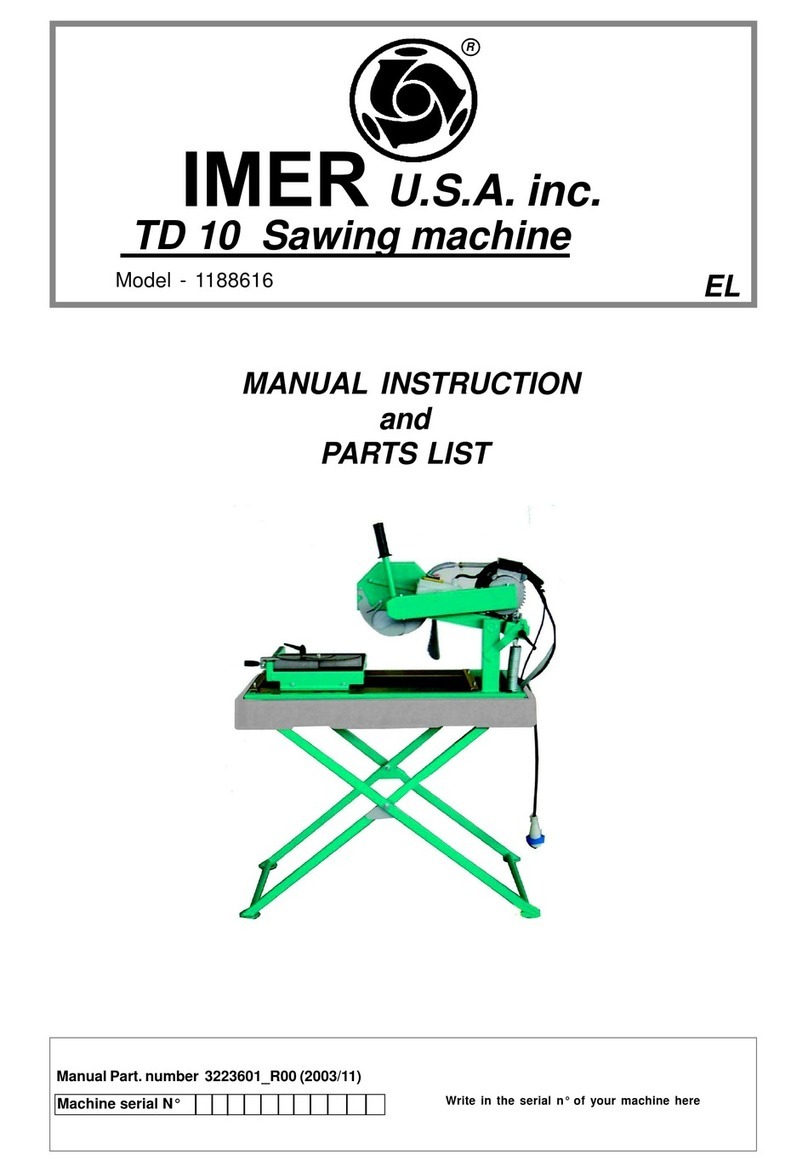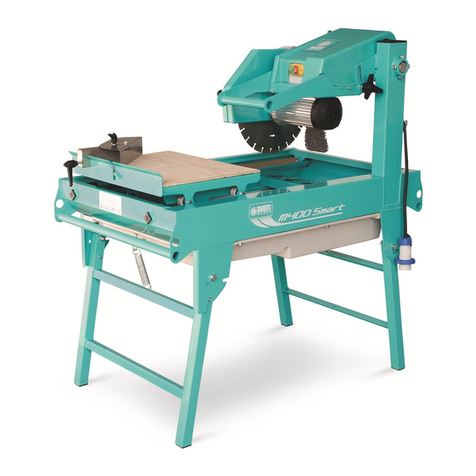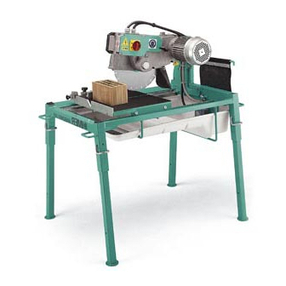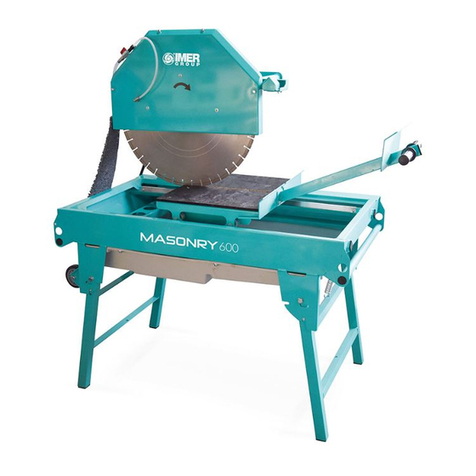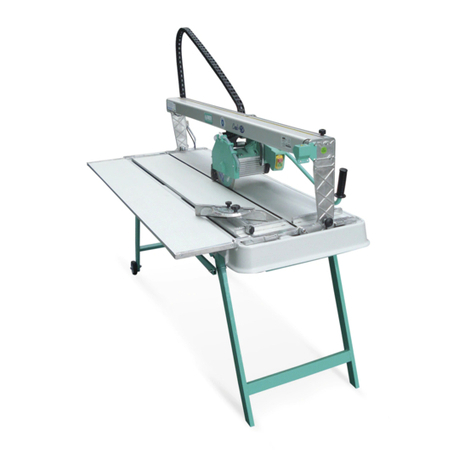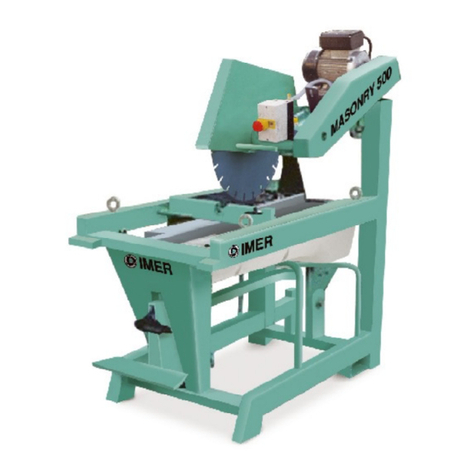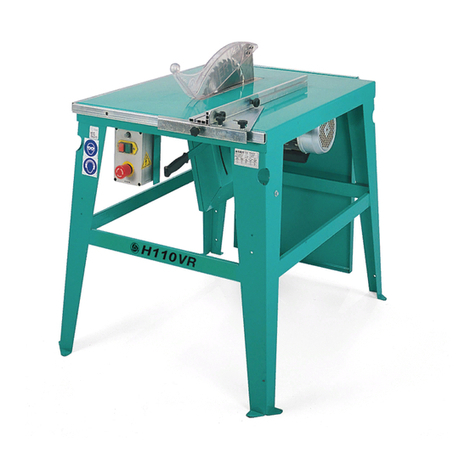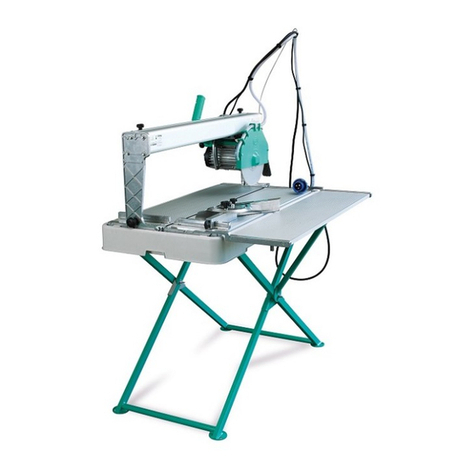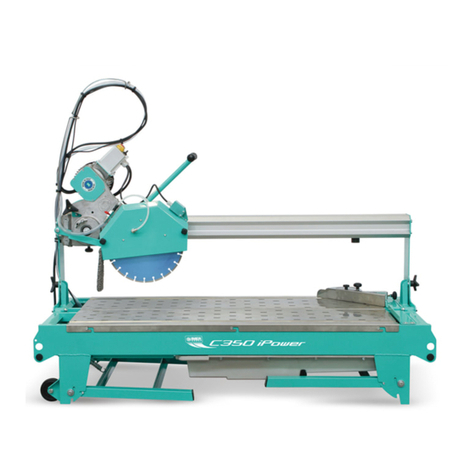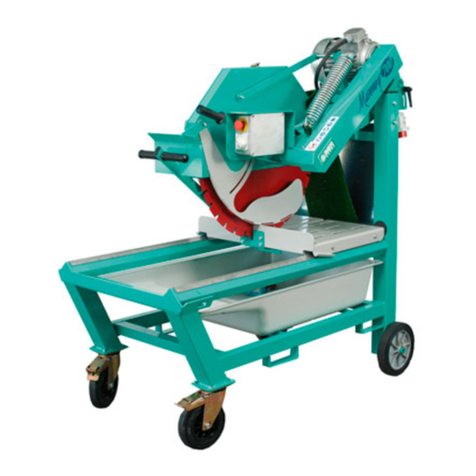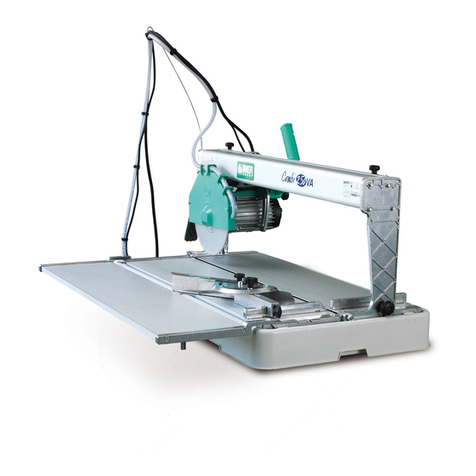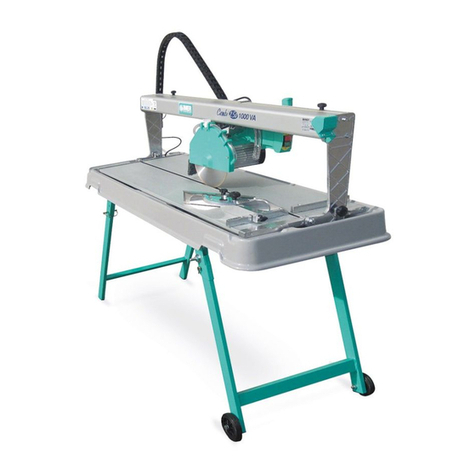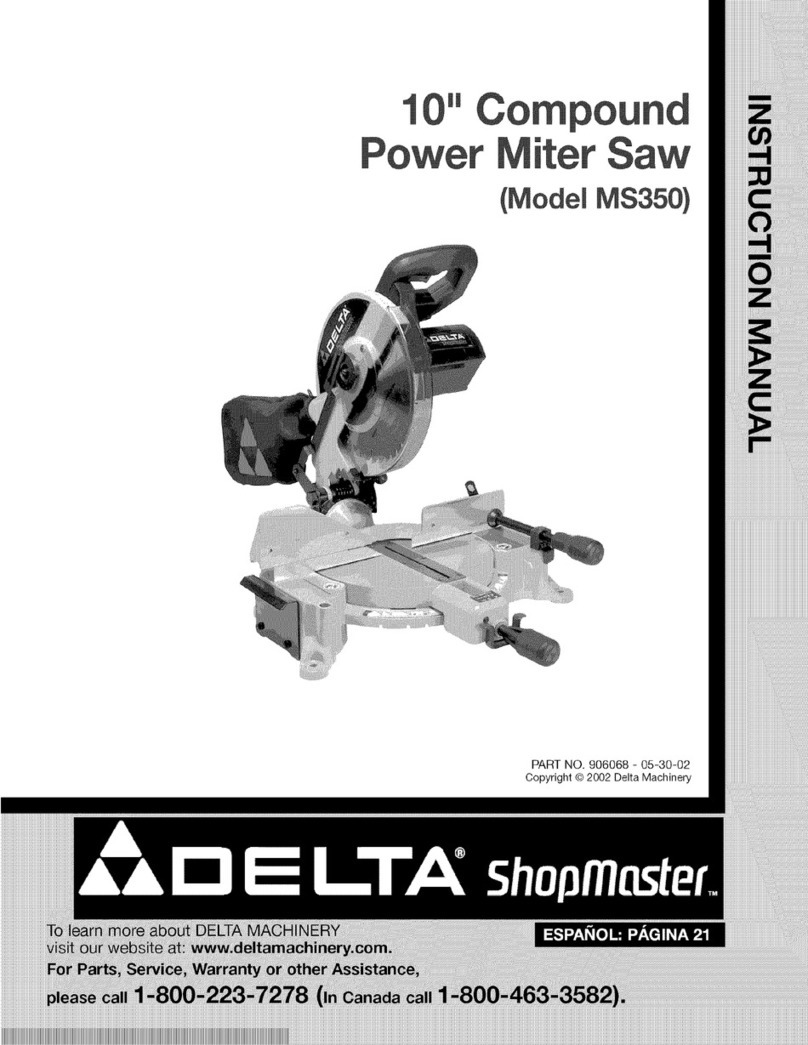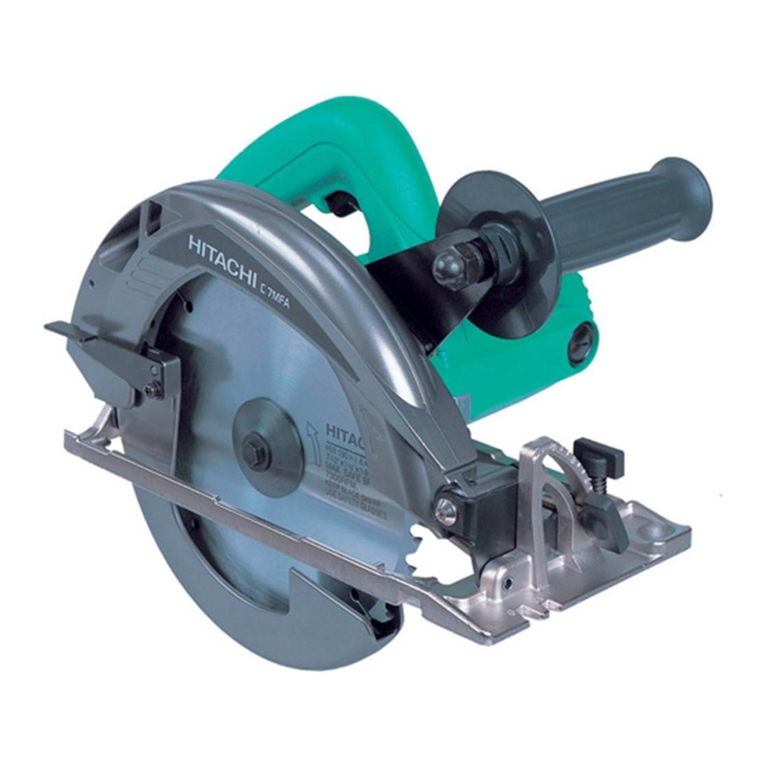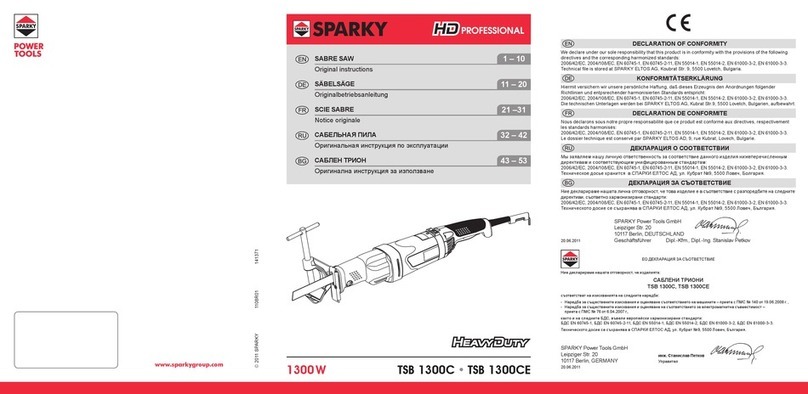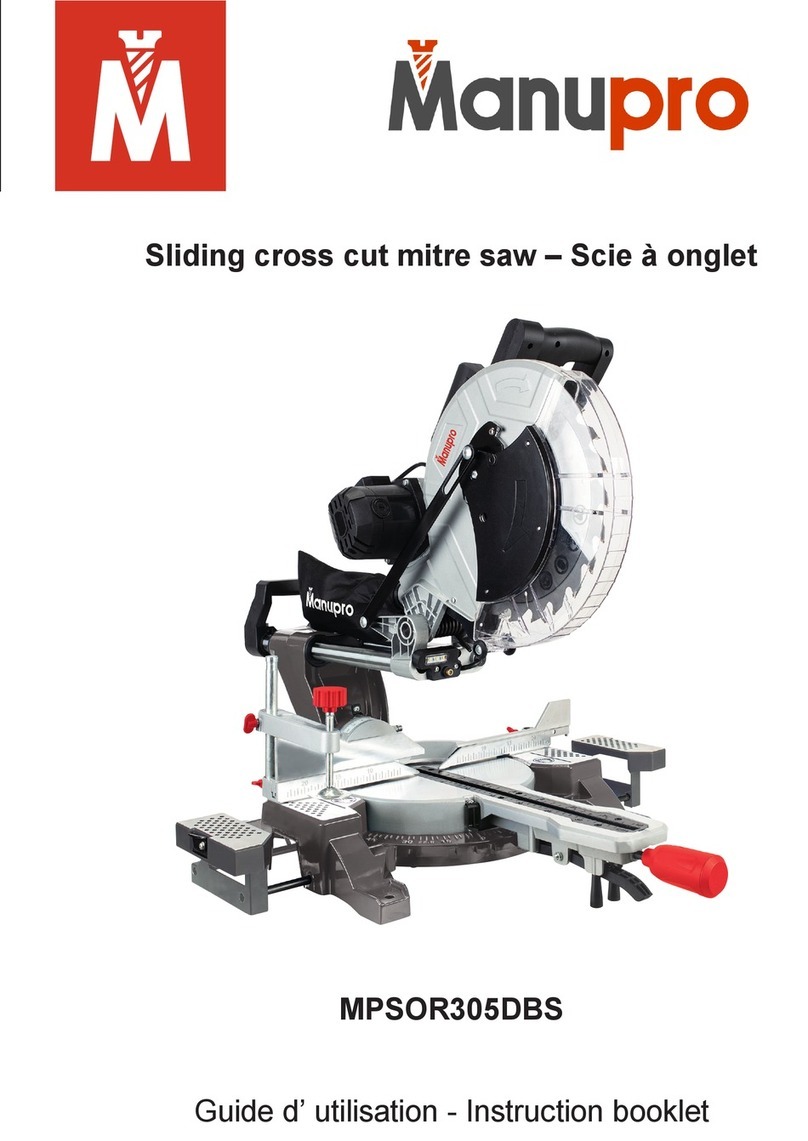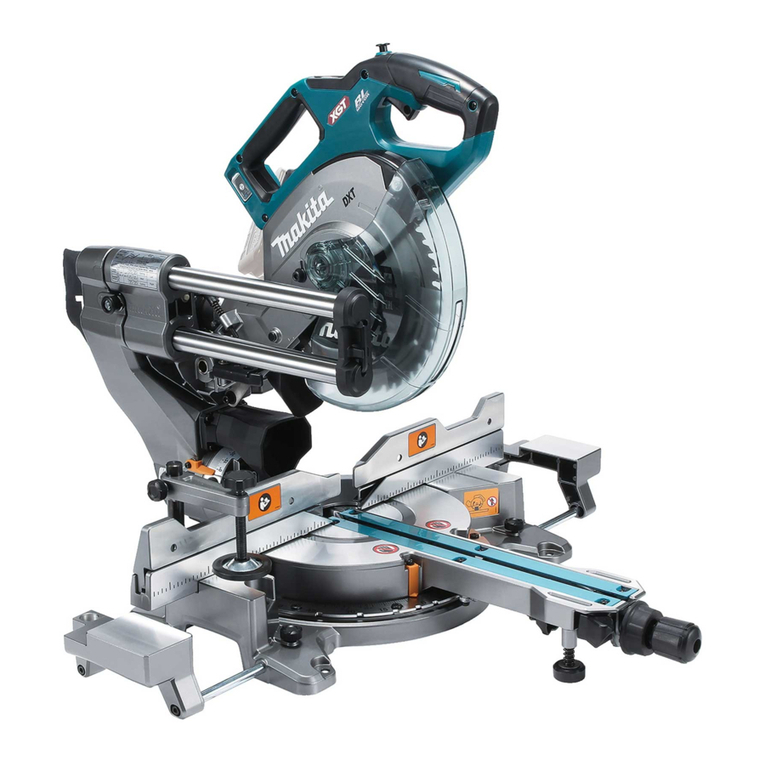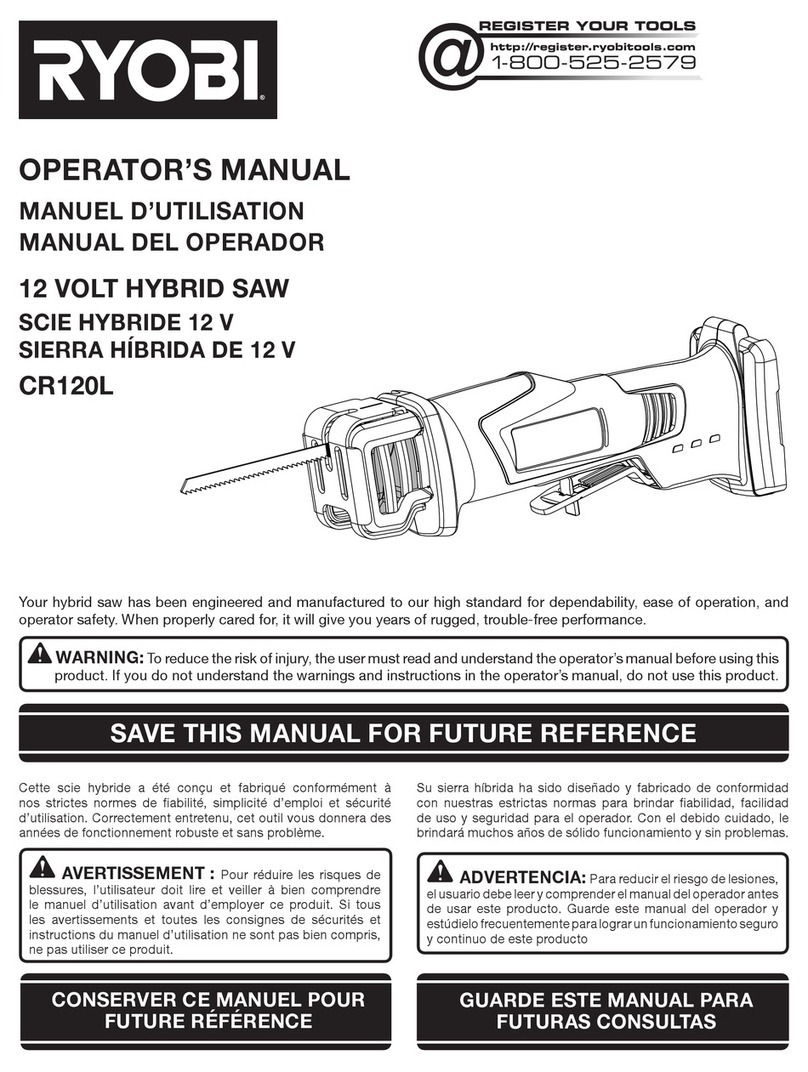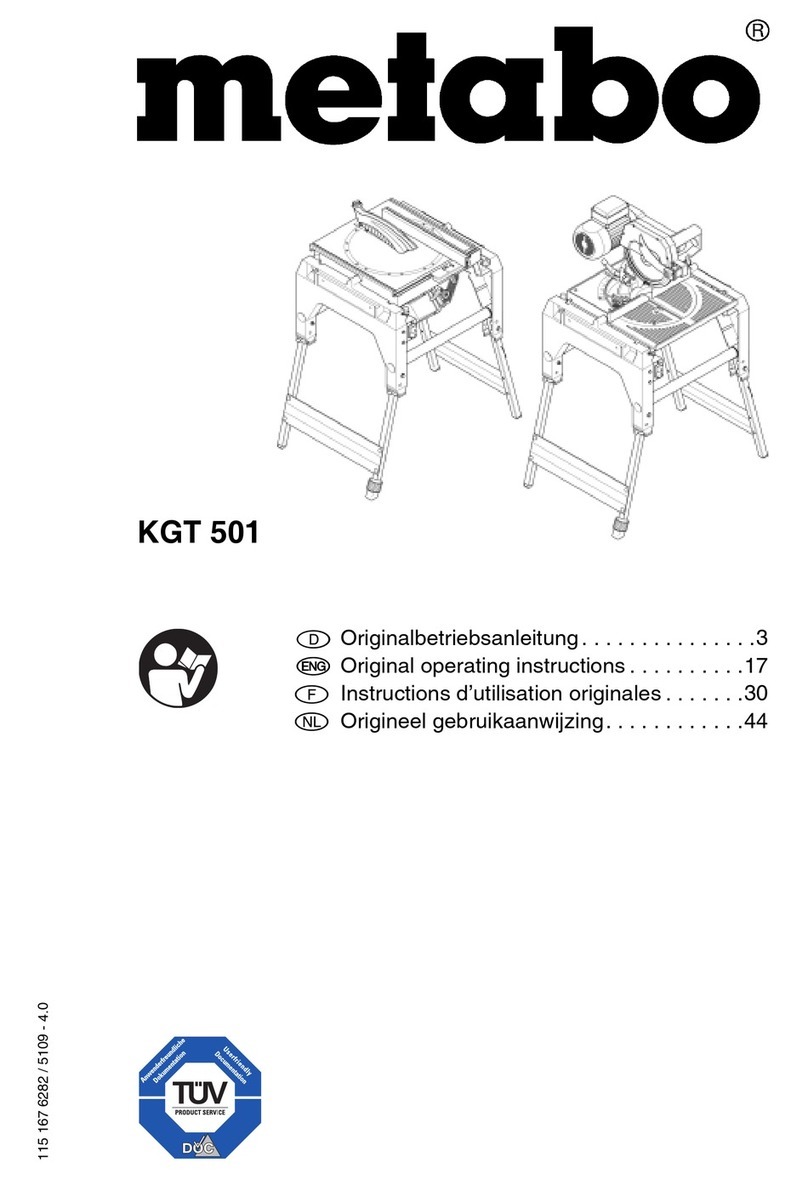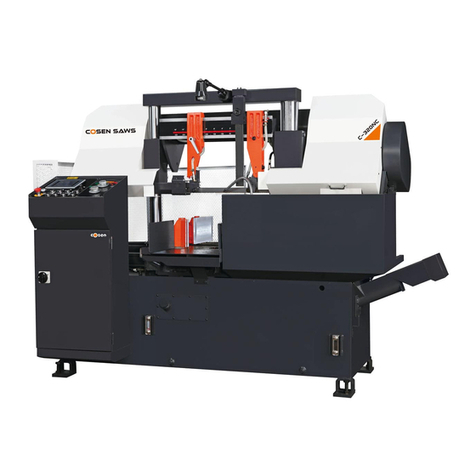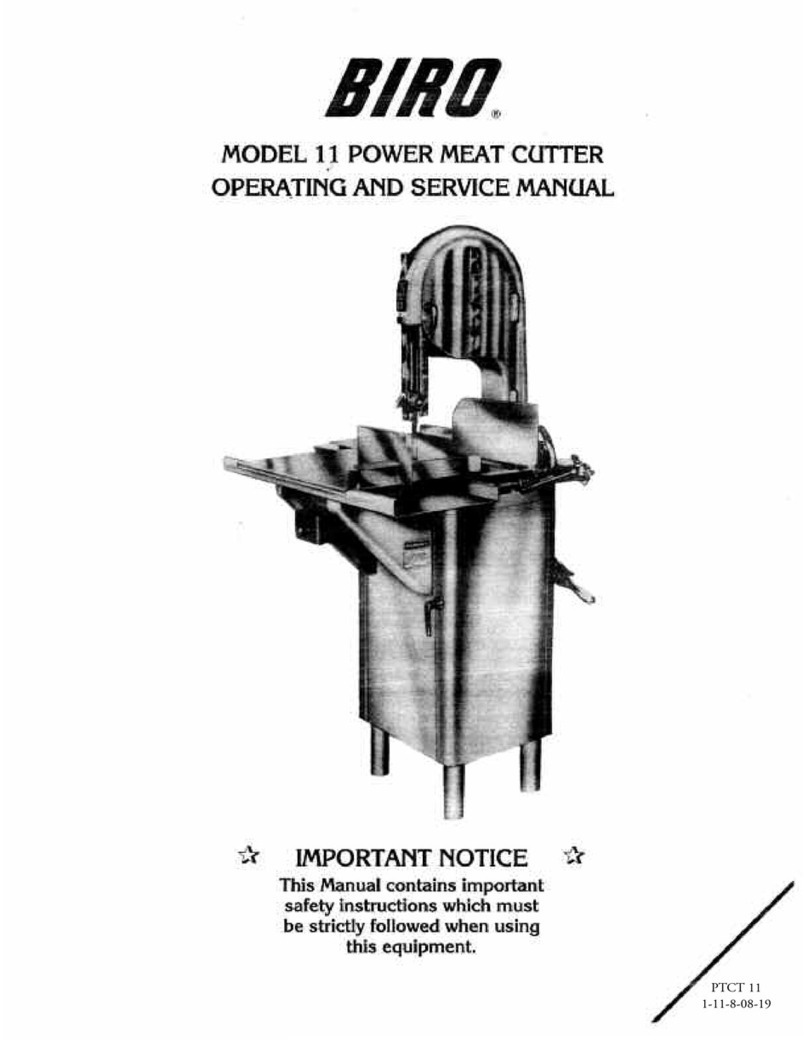IMER MASONRY 750 PLUS Guide

IMER INTERNATIONAL S.p.A
MASONRY 750 PLUS
(1188863 - 1188864)
SAWING MACHINE
Operating, maintenance, spare parts manual
IMER U.S.A. Inc.
Toll Free: 800.275.5463
www.imerusa.com
IMER EAST
221 Westhampton Place
Capitol Heights, MD 20743
Ph. 301.336.3700
Fax 301.336.6687
IMER WEST
3654, Enterprise Avenue
Hayward, CA 94545
Ph. 510.670.7970
Fax 510.783.4255
3236275
R02 2019/03

IMER INTERNATIONAL S.p.A
2
Fig. 1
POS.
I
F
GB
D
E
1 Telaio Chassis Frame Rahmen Bastidor
2 Guida scorrimento Glissiere Guide bar Führung Guía
3 Carrello portapezzo Chariot Carriage Wagen Carro
4 Leva bloccaggio carrello Chariot calage Trolley clamping Karre einspannung Carro bloqueo
5 Grembialina paraschizzi Protection
éclaboussures Spray guard Gummispritzschutz Protección contra
salpicaduras
6 Motore elettrico Moteur Motor Motor Motor
7 Quadro elettrico Boiter electrique Electric board Schalttafel Caja electra
8 Spina Fiche Plug Stecker Enchufe
9 Gruppo testa di taglio Groupe tête de
coupe Cutting head group Schneidkopf-gruppe Grupo cabeza de
corte
10 Disco Disque Blade Trennscheibe Disco
11 Carter disco Carter disc Disc cover Scheibengehäuse Cárter
12 Protezione lama
(OPTIONAL)
Protection disque
(OPTIONAL)
Blade cover
(OPTIONAL)
Scheibenschutz
(OPTIONAL)
Protección disco
(OPTIONAL)
13 Vasca acqua Cuve Drum Mischwanne Recipiente
14 Pompa acqua Pompe eau Water pump Wasserpumpe Bomba del agua
15 Leva regolazione taglio Levier réglage coupe Adjusting cut lever Hebel fuer
Schneidensregulierung
Palanca reglaje
corte
16 Blocco testa bloc de tête Head Block Kopfblock bloque de cabeza
17 Manici spingi pezzo poignées handles Griffe manijas
Tab 1
Particolare attenzione deve essere fatta alle avvertenze contrassegnate con questo simbolo :
Il faut prêter une attention toute particulière aux notes précédées de ce symbole:
Special attention must be given to warnings with this symbol:
Lesen Sie die mit diesem Symbol bezeichneten Abschnitte mit besonderer Aufmerksamkeit:
Se tiene que prestar una atención especial a las indicaciones marcadas con el signo:

IMER INTERNATIONAL S.p.A
3
Dear Customer,
Congratulations on your choice of purchase: IMER sawing
machines are the result of years of experience and are
equipped with all the latest technical innovations.
- WORKING IN SAFETY
To work in complete safety, read the following
instructions carefully.
This OPERATION AND MAINTENANCE manual must be kept
by the SITE MANAGER and be always available for
consultation.
The manual should be considered as a part of the machine
and must be kept for future reference, for the whole life of the
machine. Should the manual be lost or damaged, a
replacement copy can be ordered from the manufacturer.
The manual contains important information regarding site
preparation, installation, machine use, maintenance
procedures, and requests for spare parts. Nevertheless, the
installer and the operator must both have adequate experience
and knowledge of the machine prior to use.
In order to ensure operator safety, safe operation and long
service life, it is imperative to adhere to the instructions set out
herein and the requirements of the legislation in force
governing safety in the workplace. Use individual safety
equipment (suitable shoes and clothing, gloves, safety
glasses, etc.).
- It is mandatory to wear protective goggles.
- It is mandatory to use individual hearing protectors.
- Make sure that all signs are legible.
- It is strictly forbidden to carry out any form of
modification to the machine structure and systems.
IMER INTERNATIONAL accepts no responsibility in the event
of failure to comply with laws governing the use of this type of
equipment, with particular reference to: improper use, power
supply errors, lack of maintenance, unauthorised modification,
and failure to comply, either wholly or partially, with the
instructions set out in this manual.
IMER INTERNATIONAL reserves the right to modify features
of the saw and/or the contents of this manual, without the
obligation to update previous machines and/or manuals.
1 TECHNICAL DATA
Technical data are stated in Tab 2 and the electrical
specifications in Tab 3.
- TECHNICAL DATA
Model
Masonry 750 Plus
Max disc diameter
750 mm
Disc hole
25.4 mm
Disc revs (230V/50Hz)
976 rpm
Disc revs (400V/50Hz)
1440 rpm
Disc revs (400V/60Hz)
1475 rpm
Disc revs (220V/60Hz) SPH
1180 rpm
Disc revs (220V/60Hz) TPH
1475 rpm
Disc rotation direction
(view from the movable disc
guard)
clockwise
Cutting table dimensions
490x660 mm
Overall dimensions
(width x length x height)
850x1550x1600 mm
Overall dimensions for
transport
(width x length x height)
850x1550x1600 mm
Weight of saw in operation
285 kg
Weight for transport
202 kg
Table 2
Electrical
features
Motor
(230V/
50Hz)
Motor
(400V/50
Hz))
Motor
(400V -
60Hz)
Motor
(220 V -
60 Hz)
SPH
Motor (220
V - 60 Hz)
SPH
Power (kW)
2.2
5.5
5.5
4.0
5.5
Rated voltage
(V)
220-
240
400
400
220
220
Frequency
(Hz)
50
50
60
60
60
Absorbed
current (A)
13.8
11.6
11.5
23.2
21.6
Rpm
1420
1440
1740
1740
1730
Type of
service
S1
S3
S3
S1
S1
Insulation
class
F
F
F
f
F
Protection
class
IP55
IP55
IP55
IP 55
IP55
Capacitor
(µF)
2 x 50
180
Table 3
2 . NOISE LEVEL AND VIBRATIONS
Tab 4 gives the sound pressure level of the machine
measured at the ear of the operator when running empty
(LPA) and vibrations transmitted when it is operating.
Model
Type of
motor
LpA
Aeq
Masonry 750 Plus
Electric
95 dB
2.33 m/s
2
Table 4
3 CUTTING SPECIFICATIONS
The sawing machine is designed to cut only bricks, ceramics,
marble, granite, concrete products and similar items. The
machine must be used ONLY with segmented or continuous
rim diamond cutting blades, which must be water-cooled at all
times. The use of blades for dry cutting is strictly forbidden and
the machine must not be used to cut any material other than
those included in this specification. IMER INTERNATIONAL
accepts no responsibility for loss or damage resulting from
improper use of the machine.

IMER INTERNATIONAL S.p.A
4
4 CUTTING CAPACITY (Disc diameter 750 mm)
• Maximum cutting capacity in one pass = 300 mm
• Maximum height of the piece to be cut = 430 mm
• Minimum width of the piece to be cut = 50 mm
• Maximum cutting length with disc lowered = 500 mm
• Maximum cutting length with disc descent from above = 560
mm
5 WARNING
Do not load the machine with pieces of excessive weight (max
Kg 40).
• Pay attention to the stability of the machine: it must be
installed on a stable base with a maximum inclination of 5°
(Fig. 2).
• The machine is equipped with a brake on the front swivel
wheels. Before starting the cutting operations, lock the wheels
with the brake.
• Pay attention to the stability of the pieces before, during and
after cutting: the pieces must not protrude out of the working
surface in any case.
• Avoid spilling residual liquids from cutting by using suitable
containers.
6 SAFETY MEASURES
The IMER saw is designed to operate on construction sites
and is not equipped with its own lighting; the work site must be
well illuminated (min. 500 lux).
- Never use the saw in environments subject to the
risk of explosions and/or fire.
1. The IMER sawing machine will only run if all the safety
devices are in place and in perfect condition.
2. Do not use improvised and/or defective power supply
lines.
3. The connection lines on the site must be laid in such a
way that they cannot be damaged. Never stand the saw on
the power supply cable.
4. The plug/socket connections must be protected from
water. Use only connectors equipped with protection
against water jets (IP67).
5. Repairs to the electrical installations must only be
carried out by specialised personnel. Do not make any
adjustments or carry out any maintenance work while the
machine is powered up or running.
-To stop the saw from working, use solely the specific
switch (ref. 7, Fig. 1).
7 ELECTRICAL SAFETY
The IMER sawing machine complies with current legislation
and in particular it is equipped with:
• System for preventing unwanted start-up on return of power
after a power failure.
• Protection against short circuits.
• Thermal cut-outs protecting the motor.
8 . TRANSPORTABILITY
- Before removing the sawing machine, lock the
trolley by acting on the stopper (ref. 4 -Fig. 2).
To lift the machine, use a three-boom tie rod (ref. 1, Fig. 2),
engaging the hooks in the special connections (ref. 3, fig.4). To
carry the machine with a fork-lift truck, engage the forks in the
special seats (ref. 2, Fig. 2).
Being the machine mounted on wheels, it can be moved
manually on level surfaces in the following way:
1. make sure the front wheel brakes are released.
2. make sure that the workpiece trolley is blocked by means of
the special ratchet (ref. 4,Fig. 2).
3. acting on the handle of the workpiece trolley, tow the
machine manually; the pivoting front wheels facilitate the
movement even if not straight.
9 INSTALLATION
1. Position the machine on a horizontal plane in a stable way.
2. Lock the front wheels with the brakes.
3. Unlock the trolley from the stop that fastens it to the head
(ref. 4, Fig. 2).
10 ELECTRICAL MAINS CONNECTION
- Ensure that voltage corresponds to machine
dataplate specifications.
The power supply line must be equipped with current overload
protection (e.g. thermal-magnetic cutout) and protection
against indirect contact (e.g. residual current circuit breaker).
The electrical power distribution board at the construction site
must conform to the requirements of EN 60439-4.
The electric cable wire size must take into account the
operating currents and length of the line to avoid excessive
voltage drops (Errore. L'origine riferimento non è stata
trovata.-recommended values).
Model
Type of motor
Cable (mm²)
2.5
4.0
6.0
Masonry 750 Plus
230 V -50 hz
13.8 A
0-10
11-30
Cable length (m)
400 V - 50 Hz
11.6 A
0-10
11-30
400 V - 60 Hz
11.5 A 0-10
11-30
220 V 60 Hz SPH
23.2 A 0-20
21 - 30
220 V 60 Hz TPH
21.6 A 0-20
21 -30
Table 5
Check the integrity of the insulation and protective conductor
of the electrical supply.
Connect the machine plug to the electrical power supply and
tighten the mechanical retainer ring with IP67 protection rating.
The machine is now ready for operation.
11 COMMISSIONING THE MACHINE
Before connecting the machine to the electric mains:
1. Check that the tank contains a sufficient amount of cooling
water (minimum 60 l, maximum 90 l).
2. Make sure that the power supply mains complies with the
requirements of paragraph 10 "Electrical mains connection".
3. Then disconnect the machine on the power supply line.
4.1. For the machine with 230V/50Hz motor: press the starter
switch on the electrical panel.

IMER INTERNATIONAL S.p.A
5
4.2. For the machine with 400V/50Hz motor: Check that the
direction of rotation of the blade is in accordance with the
arrow on the guard.
- Otherwise, turn the selector on the electric plug with
a screwdriver. Check again that the direction of rotation of
the blade is in accordance with the arrow on the guard
5. Adjust the cooling water flow turning the special tap on the
back of the machine next to the cutting head (no dry cuts
should be made).
6. If everything is in order, the work can begin.
12 STOPPING THE SAWING MACHINE
- The sawing machine can be stopped by pressing
the button on the electrical panel (ref7 - Fig. 1).
To start the machine again, turn the button and then press
the start button (ref7 - Fig. 1).
13 DISC ASSEMBLY
- The disc must be assembled after stopping the
machine and disconnected the power supply.
1. Remove the water pipe after having loosened the fastening
element (ref. 4Fig. 3).
2. Unscrew the three screws that fasten the movable part of
the disc guard using the special key supplied (ref. 3, Fig. 3).
3. Loosen the lock nut (ref. 1, Fig. 3) turning it clockwise (left
thread).
4. Remove the movable flange (ref. 2, Fig. 3). Check for
damage on flanges, disc shaft and disc.
- Do not use damaged discs, with missing sectors.
- Use only discs that are suitable for the rpm shown
on the machine data plate.
- Check that the direction of rotation of the disc is the
same as marked on the disc guard.
5. Center the disc on the fixed flange, position the movable
flange (ref. 2, Fig. 3) and correctly lock the locknut (ref. 1, Fig.
3) of the disc turning it anticlockwise (left thread).
6. Refit the movable part of the disc housing, fastening it with
the respective screws (ref. 3, Fig. 3).
7. Re-insert the water pipe and tighten the fastening element
until the pipe is locked (ref. 4, Fig. 3
- Check that the disc housing is well secured.
- An incorrectly assembled disc can cause damage to
the machine and to people.
- Note that the disc must have external diameter of
750 mm, central hole diameter of 25.4 mm and maximum
thickness of 4 mm.
- Make certain that the disc to be used is suitable for
the material to be cut.
- It is forbidden to use wooden discs.
14 USE
- Leave at least 1.5 m of free space around the
machine to operate safely.
• Use the machine within the temperature range 0 - 40 °C.
• Do not allow anyone else to remain in the vicinity of the
machine during cutting.
• Do not use the machine in areas exposed to the risk of fire.
The cutting process may generate sparks, which could cause
fires or explosions.
• Transport and position the machine only after disconnecting it
from the power supply.
• Always make certain that the disc is not in contact with anything
before starting the motor.
- Check that the disc guard is in place.
• Before starting work, fill the tank with water. Restore the level
during use, when it becomes necessary. The pump must
always remain submerged.
• Insert the power plug.
- It is absolutely forbidden to remove the guards of
the machine.
- The electric motor is protected against thermal
overload: this protection intervenes stopping the machine,
after which it is necessary to wait for the time necessary
to the thermal device to cool down before it is possible to
restart the machine.
14.1 Vertical movement of the disc
- All disc adjustment operations must be carried out
with the saw machine off and disconnected power supply.
To raise or lower the disc, turn the lever (ref. 15, Fig. 1) to the
desired height from the cutting table and tighten the locking
lever (ref. 16, Fig. 1).
- Make certain that the locking knob is properly
tightened before starting the work.
14.2 Cutting
During cutting operations it is mandatory to place both hands
on the push handles of the trolley (ref. 17, Fig. 1)
It is also mandatory to wear the necessary personal protective
equipment such as:
- gloves
- eye protection
- earphones for noise protection
- Check the alignment of the disc with the cutting
line.
1. Place the piece to be cut on the workpiece trolley (ref. 3,
Fig. 1), resting firmly against the fixed stop.
2. Start the motor.
3. Wait until the water reaches the disc.
4. Make sure that nothing is in the cutting area that can hinder
the cutting phase
5. Start cutting.
6. The horizontal cutting movement is achieved by manually
moving the workpiece trolley towards the disc.
- A greater effort is required to the disc for cutting a
workpiece with greater height. Therefore, in order not to
overload the motor, the operator must adjust the carriage
speed. This speed also depends on the characteristics of
the material to be cut (hardness, toughness, etc.).
14.3 Cut from above
Unlock the cutting head acting on the locking lever (ref. 16 Fig.
1), position the piece to be cut, start the sawing machine and

IMER INTERNATIONAL S.p.A
6
start cutting from above acting on the head lever (ref. 15, Fig.
1).
14.4 Changing the disc
To change the disc refer to the "Disc assembly" paragraph.
15 Use of cutting disc diameter 700 mm
A cutting disc with a diameter of 700 mm can be installed on
the machine. The operation requires the cutting head stroke
calibration, an operation carried out as standard by the
manufacturer for a 750 mm diameter disc. Since this
adjustment, if carried out incorrectly, can damage the machine
and cause risks for people, it is recommended that it is carried
out by skilled and qualified personnel.
Proceed as follows:
1. Make sure that the machine is disconnected from the power
supply.
2. Fit the 700 mm diameter disc according to the procedure
indicated in the "Disc Assembly" paragraph.
3. Loosen the knob (ref. 16, Fig. 1).
4. Lower the cutting head until the disc is in the best cutting
position (the outer diameter of the disc must protrude 15 mm
from the cutting table).
5. Turn the screw until the desired height adjustment is
obtained and then tighten the knob (ref. 16, Fig. 1).
At this point the cutting head is adjusted for a 700 mm
diameter disc.
- If it is necessary to reassemble a 750 mm diameter
disc, it is necessary to repeat the adjustment, restoring
the factory setting.
- Note that the disc must have external diameter of
700 mm, central hole diameter of 25.4 mm and maximum
thickness of 4 mm.
16 MAINTENANCE
- Maintenance must be done by adequately trained
personnel, after switching off the electric motor, and
disconnected the power plug.
- Check the condition of the power cable before
starting to use the machine: someone may have
inadvertently and/or unconsciously damaged it.
- Make sure the guards/safety equipment are always
functional and in good condition.
In particular, keep the blade guards efficient and clean, taking
care to replace them in case of damage.
Do not leave the machine outdoors: it must be protected from
weather.
The cleaning operations to be carried out at the end of each
work shift are indicated below.
16.1 Tank cleaning
Empty the tank, removing the cap. Remove the cutting deposit
formed using a jet of water.
16.2 Tank disassembling
Empty the tank opening the cap and remove the tank laterally
from the right or left side.
16.3 Reference tables cleaning
The support tables must be kept clean. Deposits of dirt can
adversely affect the precision of cutting.
16.4 Runners cleaning
It is advisable to remove any trace of dirt that may have
formed on the runners.
16.5 Cleaning and maintenance of the cooling system
If no water is reaching, stop cutting immediately to avoid
damaging the blade.
Stop the machine and check that there is sufficient water in the
tank.
If necessary, unplug the machine and check that the pump tap,
hose or filter is not blocked.
16.6 Drive belt tensioning
1. Stop the saw and disconnect the power plug.
2. Unscrew the 4 screws that block the movable guard of the
belt (ref. 1, Fig. 4).
3. Loosen the 4 nuts (ref. 2,Fig. 4) that tighten the electric
motor on the disc holder boom.
4. Pull the belt acting on the nuts (ref. 3, Fig. 4), the correct
tensioning of the belt must be checked by means of a special
instrument to measure the vibration frequency of the belt, the
reference values to be considered are shown in the table
below
Reference values for belt tension
Type of motor
New (Hz)
Run in (Hz)
400V - 50Hz
47 Hz +/- 2%
45 Hz +/- 2%
220 V - 50Hz
45 Hz +/- 2%
43 Hz +/- 2%
400 V - 60 Hz
47 Hz +/- 2%
45 Hz +/- 2%
220 V - 60 Hz
45 Hz +/- 2%
43 Hz +/- 2%
Table 6
5. Tighten the nuts of the electric motor (ref. 2, Fig. 4),
checking the alignment of the motor pulley and the disc pulley.
6. Refit the belt guard and lock it with the 4 screws (ref. 1, Fig.
4).
16.7 Replacing the drive belt
1. Switch off the electric motor and disconnect the power plug.
2. Unscrew the 4 screws that block the movable guard of the
belt (ref. 1, Fig. 3).
3. Loose (ref 2 Fig. 4) that tighten the motor plates (ref. 137,
TAV2) on the disc holder boom.
4. Loosen the belt acting on the nuts (ref. 3, Fig. 4) and
replace it with the new one.
5. Pull the belt acting on the nuts (ref. 3, Fig. 4):the correct
tension measured with frequency meter must be equal to the
value shown in Tab 6.
6. Tighten the nuts on the motor plates (ref. 2, Fig. 4),
checking the alignment of the motor pulley and the disc pulley.
7. Refit the belt guard and lock it with the 4 screws (ref. 1, Fig.
4).
16.8 Repairs
- All maintenance operations must be performed
exclusively with the machine switched off, and the power
plug disconnected from the mains.
- If any guards are removed for repairs, ensure they
are correctly refitted at the end of work.
Use exclusively original IMER spare parts; modifications to
parts are strictly prohibited.

IMER INTERNATIONAL S.p.A
7
17 RESIDUAL RISKS AND SAFETY NOTICES
Although the sawing machine has been manufactured fully in
compliance with current regulations, residual risks exist that
cannot be eliminated and involve the use of appropriate
individual protection devices. The machine is equipped with
notices to indicate the residual risks and how to avoid them.
NOISE HAZARD
Wear ear defenders
HAND CRUSHING/SHEARING HAZARD
Wear gloves
EYE INJURY HAZARD
Wear safety glasses
INCORRECT USE HAZARD
Read the manual before operating the
machine
Cutting with water is compulsory
TRAPPING/CRUSHING AND SHEARING HAZARD
Do not remove the guards
Do not touch drive components
Danger of cutting
ELECTROCUTION HAZARD
Danger - electrical power
Note that the employer is responsible for ensuring his workers
use individual safety equipment.
SILICA DUST WARNING
Grinding/cutting/drilling of masonry, concrete, metal and other
materials with silica in their composition my give off dut or mists
cintainig crystalline silica. Silica is a basic component of sand, quartz,
brick clay, granite and numerous other minerals and rocks. Repeated
and/or substantial inhalation of airborne crystalline silica can cause
serious or fatal respiratory diseases, including silicosis. In addition,
California and some other authorities have listed respirable
crystallinesilica as a substance known to cause cancer. Whwn cutting
such materials, always follow respiratory precautions.
Use appropriate NIOSH-approved respiratory protection where dust
hazard may occur. Paper masks or surgical masks without a NIOSH
approval number are not recommended because they do little to
protect the worker. For more information about respirator programs,
including what respirators have received NIOSH approval as safe and
effective, please visit the NIOSH website at:
http://www.cdc.gov/niosh/topics/respirators
Observe OSHA regulations for respirator use (29 C:F.R. § 1910.134).
Visit http://www.osha.gov for more information.
California proposition 65 message
Some dust created by power sanding, sawing, grinding, drilling, and
other construction activities contain chemicals know (to the State of
California) to cause cancer, birth defects or other reproductive harm.
Some examples of these chemicals are:
-Lead, from lead-based paints
-Crystalline silica, from bricks and cement and other masonry
products
-Arsenic and chromium, from chemically treated lumber
For further information , consult the following sources:
http://www.osha.gov/dsg/topics/silicacrystalline/index.html
http://www.cdc.gov/niosh/docs/96-112/
http://oehha.ca.gov/prop65/law/P65law72003.html
http://www.dir.ca.gov/Title8/sub4.html
http://www.P65warnings.ca.gov
Your risk from these exposures varies depending on how often you do
this typer of work. To reduce your exposure to these chemicals, work
in a well-ventilated area, and work with approved safety equipment,
such as dust masks that are specially designed to filter out
microscopic particles. Where use of a dust extraction device is
possible, it should be used. To achieve a high level oof dust
collection, use an industrial HEPA vacuum cleaner. Observe OSHA
29 CFR part 1926.57 and 1926.103.
18 TROUBLESHOOTING
- CAUTION!!! All maintenance operations must be
performed exclusively with the machine stopped off and
the power plug disconnected from the mains.
Problem
Causes
Corrective action
Motor fails to start
when switch is
operated
Voltage not reaching
supply line
Check the line *
Electrical socket and
plug are not properly
connected
Restore correct
connection
The power cable from
the plug to the panel is
cut off
Change the cable *

IMER INTERNATIONAL S.p.A
8
An electrical wire in the
motor terminal board is
disconnected
Restore the
connection *
An electrical wire in the
electrical panel is
disconnected
Restore the
connection *
The ON switch is faulty
Replace the switch *
A fuse has blown
Replace the fuse *
The thermal safety
device has been
triggered
Wait a few minutes
and try again
Difficult trolley
horizontal sliding
Dirty runners
Clean the runners
No cooling water
reaching disc
Refer to "cleaning and maintenance of the
cooling system" (par. 17.5)
Disc fails to cut
The disc is worn
Replace with new
disc
Transmission belt not
tensioned
Tighten the belts
Motor starts but disc
does not turn
Belt broken
Replacing the drive
belt
* Operation to be carried out by an electrician
Tools supplied
• double-ended wrench CH 10-13
• open ended wrench CH 36

IMER INTERNATIONAL S.p.A
9
INSTRUCCIONES TRADUCIDAS
Apreciado Cliente:
Enhorabuena por su compra, la sierra IMER es el resultado de
años de experiencia e incorpora soluciones técnicas
innovadoras para ofrecer la máxima fiabilidad.
- TRABAJAR CON SEGURIDAD
Para trabajar en condiciones seguras es fundamental leer
con atención las siguientes instrucciones.
El presente manual de USO Y MANTENIMIENTO debe ser
conservado en las obras por el CAPATAZ y estar siempre
disponible para que pueda consultarse en cualquier momento.
El manual debe considerarse parte de la máquina y
conservarse hasta el final de su vida útil para futuras
consultas. Si se pierde o se daña, solicite un nuevo ejemplar
al fabricante.
El manual contiene importantes indicaciones sobre la
preparación del obrador y la instalación, el uso, mantenimiento
y pedido de repuestos de la máquina. De todas formas, es
indispensable que el técnico de mantenimiento y el usuario
tengan experiencia y un conocimiento adecuado de la
máquina.
Para garantizar la seguridad del operador, un funcionamiento
correcto y una larga duración del equipo, deben respetarse no
sólo todas las instrucciones del manual sino también las
normas de seguridad y prevención de accidentes laborales
establecidas por la legislación vigente. Haga uso de las
protecciones individuales (calzado y ropa adecuados, guantes,
gafas, etc.).
- El uso de gafas de protección es obligatorio.
- El uso de medios de protección auditiva
individuales es obligatorio.
- Mantener siempre legibles las señales.
- Se prohíbe modificar de cualquier modo la
estructura o las distintas partes de la máquina.
IMER INTERNATIONAL declina toda responsabilidad cuando
no se respeten las leyes que regulan el uso de estos equipos,
y, en concreto: uso indebido, errores de alimentación, falta de
mantenimiento, modificaciones no autorizadas e
incumplimiento total o parcial de las instrucciones ilustradas
en este manual.
IMER INTERNATIONAL se reserva el derecho de modificar
las características de la sierra y el contenido del manual sin
obligación de actualizar la máquina o los manuales
precedentes.
1 DATOS TÉCNICOS
Los datos técnicos figuran en la Errore. L'origine riferimento
non è stata trovata. y las características eléctricas en la
Errore. L'origine riferimento non è stata trovata..
- DATOS TÉCNICOS
Modelo
Masonry 750 Plus
Diámetro máximo del disco
750 mm
Orificio del disco
25,4 mm
Revoluciones del disco (230
V/50 Hz)
976 rpm
Revoluciones del disco (400
V/50 Hz)
1440 rpm
Revoluciones del disco (400
V/60 Hz)
1475 rpm
Revoluciones del disco (220
V/60 Hz) SPH
1180 rpm
Revoluciones del disco (220
V/60 Hz) SPH
1475 rpm
Sentido de rotación del
disco
(vista desde el cárter del
disco móvil)
horario
Medidas de la mesa de
corte
490x660 mm
Medidas
(ancho x largo x alto)
850x1550x1600 mm
Medidas para transporte
(ancho x largo x alto)
850x1550x1600 mm
Peso de la sierra en servicio
285 kg
Peso para trasporte
202 kg
Tabla 2
Características
eléctricas
Motor
(230
V/50
Hz)
Motor
(400 V/50
Hz)
Motor (400
V - 60 Hz)
Motor
(220 V -
60 Hz)
SPH
Motor
(220 V -
60 Hz)
TPH
Potencia (kW)
2.2
5.5
5.5
4
5.5
Tensión
nominal (V)
220-
240
400
400
220
220
Frecuencia (Hz)
50
50
50
60
60
Corriente
absorbida (A)
13.8
11.6
11.5
23.2
21.6
Revoluciones
(rpm)
1420
1440
1740
1740
1730
Tipo de servicio
S1
S3
S3
S1
S1
Clase de
aislamiento
F
F
F
f
F
Grado de
protección
IP55
IP55
IP55
IP55
IP55
Condensador
(µF)
2 x 50
180
Tabla 3
2 . NIVEL DE EMISIÓN SONORA Y VIBRACIONES
TRANSMITIDAS
En la Errore. L'origine riferimento non è stata trovata. figura el
nivel de presión sonora medido en el oído del operador en
vacío (LPA) y de las vibraciones transmitidas durante el
trabajo.
Modelo
Tipo de
motor
LpA
Aeq
Masonry 750 Plus
Eléctrico
95 dB
2.33 m/s
2
Tabla 4

IMER INTERNATIONAL S.p.A
10
3 HERRAMIENTAS DE CORTE
La sierra está diseñada para cortar solamente ladrillos,
cerámica, mármol, granito, productos de cemento y similares.
Deben emplearse exclusivamente hojas de diamante con
canto de corte continuo o en sectores, refrigerados por agua.
No utilice por ningún motivo hojas para corte en seco, ni corte
materiales distintos de los indicados. IMER INTERNATIONAL
declina toda responsabilidad por daños derivados de un uso
impropio de la máquina.
4 CAPACIDAD DE CORTE (Diámetro del disco 750 mm)
• Capacidad de corte máxima en una sola pasada= 300 mm
• Altura máxima de la pieza que se va a cortar:= 430 mm
• Anchura mínima de la pieza que se va a cortar:= 50 mm
• Longitud de corte máxima con disco bajado= 500 mm
• Longitud de corte máxima con bajada vertical del disco= 560
mm
5 ADVERTENCIAS
• No cargue en la máquina piezas de peso excesivo (máx 40
kg).
• Preste atención a la estabilidad de la maquina: debe estar
instalada sobre un plano horizontal estable con una inclinación
máxima de 5° (Fig. 2).
• La máquina está dotada de freno en las ruedas delanteras
pivotantes. Antes de comenzar las operaciones de corte,
bloquee las ruedas con el freno.
• Preste atención a la estabilidad de las piezas antes, durante
y después del corte: en ningún caso las piezas deben
sobresalir de la mesa de trabajo.
• No vierta en el medio ambiente los líquidos residuales del
corte; coloque recipientes apropiados para recogerlos.
6 MEDIDAS DE SEGURIDAD
La sierra IMER ha sido proyectada para trabajar en obras de
construcción y no dispone de iluminación propia. Por lo tanto,
el lugar de trabajo deberá estar suficientemente iluminado
(mín. 500 lux).
- La sierra no debe emplearse en ambientes donde
exista peligro de explosión o de incendio.
1. Utilice la sierra IMER solo si tiene todos los dispositivos
de protección instalados y en perfectas condiciones.
2. No utilice cables de alimentación improvisados o
defectuosos.
3. Los cables de alimentación deben tenderse de manera
que tal que no puedan ser dañados. No apoye la sierra
sobre el cable de alimentación.
4. Las conexiones deben disponerse de manera tal que el
agua no pueda penetrar. Utilice exclusivamente
conectores protegidos contra chorros de agua (IP67).
5. Las reparaciones de las instalaciones eléctricas deben
ser realizadas exclusivamente por técnicos
especializados. No efectúe operaciones de reglaje o
mantenimiento con la máquina conectada a la corriente o
en funcionamiento.
-Para detener la sierra se ha de utilizar
exclusivamente el interruptor especifico (ref. 7, Fig. 1).
7 SEGURIDAD ELÉCTRICA
La sierra IMER cumple con lo dispuesto por la normativa
vigente y en concreto está equipada con:
• Sistema contra el arranque fuera de tiempo tras un corte de
energía eléctrica.
• Protección contra cortocircuitos.
• Protección térmica del motor.
8 . TRANSPORTE
- Antes de desmontar la sierra bloquear el carro
mediante el bloqueo de seguridad (ref. 4 -Fig. 2).
Para levantar la máquina, use un tirante de tres brazos (ref. 1,
Fig. 2), fijando los ganchos en los conexiones especificas (ref.
3, fig. 4). Para transportar la máquina con una carretilla
elevadora, introducir las horquillas en las sedes específicas
(ref. 2, Fig. 2).
Al estar la máquina montada sobre ruedas, se puede mover
manualmente sobre superficies planas de la siguiente manera:
1. Asegúrese de desbloquear los frenos de las ruedas
delanteras.
2. Asegúrese de que el carro que sujeta la pieza esté
bloqueado por medio del trinquete especial (ref. 4,Fig. 2.
3. Actuando sobre el mango del carro que sujeta la pieza,
remolque la máquina manualmente; las ruedas delanteras
pivotantes facilitan el movimiento incluso no recto.
9 INSTALACIÓN
1. Coloque la máquina en un plano horizontal de forma
estable.
2. Bloquee las ruedas delanteras con los frenos.
3. Suelte el carro del bloqueo de seguridad que lo fija al
cabezal (ref. 4, Fig. 2).
10 CONEXIÓN A LA RED ELÉCTRICA
- Compruebe que la tensión disponible sea igual a la
que se indica en la placa de datos de la máquina.
La línea de alimentación eléctrica debe estar dotada de
protección contra sobrecorrientes (p. ej. con un interruptor
magnetotérmico) y contra los contactos indirectos (p. ej. con
un interruptor diferencial).
El cuadro de distribución de la energía eléctrica del lugar de la
obra debe cumplir con la norma EN 60439-4.
Las dimensiones de los conductores del cable de alimentación
eléctrica deben ser adecuadas para la corriente de
funcionamiento y para la longitud de la línea, a fin de evitar
caídas excesivas de tensión (Errore. L'origine riferimento
non è stata trovata. - valores recomendados).
Modelo
Tipo de motor
Sección cable (mm²)
2.5
4.0
6.0
Masonry 750 Plus
230 V -50 hz
13.8 A
0-10
11-30
Longitud del cable (m)
400 V - 50 Hz
11.6 A
0-10
11-30
400 V - 60 Hz
11.5 A 0-10
11-30
220 V 60 Hz SPH
23.2 A 0-20
21 - 30
220 V 60 Hz TPH
21.6 A 0-20
21 -30
Tabla 5

IMER INTERNATIONAL S.p.A
11
Asegúrese de la integridad del aislamiento y del conductor de
protección de la alimentación eléctrica.
Conecte la clavija eléctrica de la maquina en la toma de
corriente y enrosque la tuerca de retención con grado de
protección IP67.
Ahora, la maquina está preparada para empezar a trabajar.
11 PUESTA EN SERVICIO DE LA MÁQUINA
Antes de conectar la máquina a la fuente de alimentación:
1. Compruebe que el recipiente contenga una cantidad
suficiente de agua de enfriamiento (mínimo 60 l, máximo 90 l).
2. Asegúrese de que el circuito de alimentación cumpla con
los requisitos del párrafo 10 "Conexión a la red eléctrica".
3. Después conecte la máquina a la línea eléctrica de
alimentación.
4.1. Para la maquina con motor de 230 V/50 Hz: presione el
interruptor de arranque en el panel eléctrico.
4.2. Para la maquina con motor de 380 V/50 Hz: Compruebe
que el sentido de rotación de la hoja esté de acuerdo con la
flecha situada en el cárter de protección.
- De lo contrario, gire el selector en el enchufe
eléctrico con un destornillador. Compruebe otra vez que
el sentido de rotación de la hoja esté de acuerdo con la
flecha situada en el cárter de protección.
5. Ajuste el flujo de agua de refrigeración girando el grifo
especial en la parte posterior de la máquina junto al cabezal
de corte (no se deben hacer cortes en seco).
6. Si todo está en orden, el trabajo puede comenzar.
12 PARADA DE LA SIERRA
- La sierra se puede detener presionando el botón
situado en el panel eléctrico (ref 7 - Fig. 1).
Para volver a poner en marcha la máquina, gire el botón y
luego presione el botón de arranque (ref 7 - Fig. 1).
13 MONTAJE DISCO
- El montaje del disco debe realizarse después de
haber detenido la máquina y desconectado la fuente de
alimentación.
1. Retire el tubo del agua después de aflojar el elemento de
fijación (ref. 4, Fig. 3).
2. Desatornille los tres tornillos que fijan la parte móvil del
cárter del disco con la llave especial que se incluye (ref. 3, Fig.
3).
3. Afloje la tuerca de bloqueo (ref. 1, Fig. 3) girándola en el
sentido de las agujas del reloj (rosca izquierda).
4. Retire la brida móvil (ref. 2, Fig. 3). Compruebe si hay
daños en las bridas, el eje del disco y el disco.
- No use discos con sectores deteriorados o rotos.
- Emplee sólo discos idóneos para el número de
revoluciones indicado en la placa de datos de la máquina.
- Compruebe que el disco gire en el sentido indicado
en el cárter del disco.
5. Centre el disco en la brida fija, coloque la brida móvil (ref. 2,
Fig. 3) y bloquee correctamente la tuerca de bloqueo (ref. 1,
Fig. 3) del disco girándolo en el sentido contrario a las agujas
del reloj (rosca izquierda).
6. Vuelva a colocar la parte móvil del cárter del disco, fijándola
con los tornillos correspondientes (ref. 3, Fig. 3).
7. Vuelva a insertar el tubo del agua y apriete el elemento de
fijación hasta que el tubo esté bloqueado (ref. 4, Fig. 3
- Compruebe que el cárter del disco esté bien fijado.
- Un disco montado incorrectamente puede causar
daños a la máquina y a las personas.
- El disco debe tener un diámetro exterior de 750 mm,
un orificio central de 25,4 mm y un espesor máximo de 4
mm.
- Asegúrese de que el disco es apto para el material
que va a cortar.
- El uso de discos para madera está prohibido.
14 USO
- Deje al menos 1,5 m de espacio libre alrededor de la
máquina para operar de forma segura.
• Use la máquina dentro del rango de temperatura 0 - 40 °C.
• No permita que otras personas permanezcan cerca de la
máquina durante el corte.
• No utilice la máquina en una zona con peligro de incendio.
Una chispa puede provocar incendios o explosiones.
• Transporte y ubique la máquina solo después de
desconectar la alimentación eléctrica.
• Antes de poner el motor en marcha, asegúrese de que el disco no
esté en contacto con ningún objeto.
- Compruebe que la protección del disco esté en su
sitio.
• Llene siempre el recipiente de agua antes de empezar a
trabajar. Durante el uso, restaure el nivel cuando sea
necesario. La bomba debe permanecer siempre sumergida.
• Conecte el enchufe de alimentación eléctrica.
- Está absolutamente prohibido quitar las
protecciones de la máquina.
- El motor eléctrico está protegido contra sobrecargas
térmicas: esta protección detiene la máquina y, una vez
que se ha detenido, es necesario esperar el tiempo
suficiente para que se enfríe el dispositivo térmico antes
de volver a poner en marcha la máquina.
14.1 Movimiento vertical del disco
- Todas las operaciones de reglaje del disco deben
realizarse con el motor apagado y la alimentación
eléctrica desconectada.
Para subir o bajar el disco, levante la palanca (ref. 15, Fig. 1)
hasta la altura deseada del plano de corte y apriete la palanca
de bloqueo (ref. 16, Fig. 1).
- Antes de empezar el trabajo, compruebe que la
palanca de bloqueo está bien apretada.
14.2 Corte
Durante las operaciones de corte, es obligatorio colocar
ambas manos en las empuñaduras del carro (ref.17, Fig. 1)
También es obligatorio llevar el equipo de protección personal
necesario, como:
- guantes
- gafas para protección
- auriculares para protección contra el ruido

IMER INTERNATIONAL S.p.A
12
- Compruebe la alineación del disco respecto a la
línea de corte.
1. Coloque la pieza que se va a cortar en el carro (ref. 3, Fig.
1), apoyado de forma estable contra el tope fijo del carro.
2. Poner en marcha el motor.
3. Espere hasta que el agua llegue al disco.
4. Asegúrese de que no haya nada en el área de corte que
pueda obstaculizar la fase de corte.
5. Comience a cortar.
6. El movimiento de corte horizontal se logra moviendo
manualmente el carro que sujeta la pieza hacia el disco.
- Cuanto mayor es la altura de corte, mayor es el
esfuerzo que realiza el disco para cortar la pieza. De modo
que para no sobrecargar el motor, el operador debe
ajustar la velocidad de avance del carro. Esta velocidad
también depende de las características del material que
se va a cortar (dureza, cohesión, etc.).
14.3 Corte con bajada vertical
Desbloquee el cabezal de corte mediante la palanca de
bloqueo (ref. 16,Fig. 1), coloque la pieza que va a cortar,
ponga en marcha la sierra y comience a cortar con un
descenso desde la parte superior actuando sobre la palanca
del cabezal (ref. 15, Fig. 1).
14.4 Cambio del disco
Para cambiar el disco, consulte el párrafo "Montaje del disco".
15 Uso del disco de corte de 700 mm de diámetro
En la maquina se puede montar un disco de corte de 700 mm
de diámetro. El fabricante realiza la calibración de la carrera
del cabezal de corte para un disco de 750 mm de diámetro.
Dado que este ajuste, si no se realiza correctamente puede
dañar la máquina y es un riesgo para las personas, se
recomienda que lo lleve a cabo personal competente y
cualificado.
Proceda de la siguiente manera:
1. Asegúrese de que la máquina esté desconectada de la
fuente de alimentación.
2. Coloque el disco de 700 mm de diámetro de acuerdo con el
procedimiento indicado en el párrafo "Montaje del disco".
3. Afloje el pomo (ref. 16, Fig. 1).
4. Baje el cabezal de corte hasta que el disco esté en la
posición de corte óptima (el diámetro exterior del disco debe
sobresalir 15 mm de la mesa de corte).
5. Gire el tornillo hasta obtener el ajuste de altura deseado y
luego apriete el pomo (ref. 16, Fig. 1).
De este modo el cabezal de corte está ajustado para un disco
de 700 mm de diámetro.
- Si desea volver a montar un disco de 750 mm de
diámetro, es necesario repetir el ajuste y restaurar la
configuración de fábrica.
- El disco debe tener un diámetro exterior de 700 mm,
un orificio central de 25,4 mm y un espesor máximo de 4
mm.
16 MANTENIMIENTO
- Las operaciones de mantenimiento deben ser
efectuadas por personal experto después de apagar el
motor, desconectar la alimentación eléctrica y vaciar la
cuba de mezcla.
- Compruebe el estado del cable eléctrico cada vez
que se utilice la maquina: alguien podría haberlo dañado
involuntariamente.
- Mantenga siempre las protecciones íntegras y en
buen estado de funcionamiento.
En concreto, mantenga las protecciones de la hoja limpias y
en buen estado, teniendo cuidado de reemplazarlas si están
dañadas.
No deje la máquina a la intemperie.
A continuación se describen las operaciones de limpieza que
deben efectuarse al final de cada turno de trabajo.
16.1 Limpieza del recipiente
Quite el tapón y vacíe el recipiente. Limpie los residuos del
corte con un chorro de agua.
16.2 Desmontaje del recipiente
Abra el tapón para vaciar el recipiente y quite el recipiente
lateralmente desde el lado derecho o el izquierdo.
16.3 Limpieza de las mesas de apoyo
Las mesas de apoyo deben mantenerse limpias. Los restos de
suciedad en dichas superficies pueden causar imprecisiones
en los cortes.
16.4 Limpieza de las mesas de apoyo
Se aconseja quitar la suciedad depositada en las guías.
16.5 Limpieza y mantenimiento del equipo de refrigeración
Si el agua no llega al disco, interrumpa inmediatamente el
corte para no dañar la hoja.
Una vez parada la máquina, controle que haya suficiente agua
en el recipiente.
Si es necesario, con la máquina desenchufada, controle que
no haya obstrucciones en el grifo, en el tubo o en el filtro de la
bomba.
16.6 Compruebe el tensado de la correa de transmisión
1. Pare la sierra y desconecte la clavija de la alimentación
eléctrica.
2. Desatornille los 4 tornillos que aseguran la protección de la
correa móvil (ref. 1, Fig. 4).
3. Afloje las 4 tuercas (ref. 2, Errore. L'origine riferimento
non è stata trovata.) que fijan el motor eléctrico en el brazo
que sujeta el disco.
4. Tense la correa mediante las tuercas (ref. 3, Fig. 4), la
comprobación del tensado de la correa deberá realizarse
mediante el instrumento especial que permite medir la
frecuencia de vibración de la correa. Los valores de referencia
a tener en cuenta se muestran en la siguiente tabla
Valores de referencia para el tensado de la correa
Tipo de motor
Nueva (Hz)
Usada (Hz)
380 V - 50 Hz
47 Hz +/- 2%
45 Hz +/- 2%
220 V - 50 Hz
45 Hz +/- 2%
43 Hz +/- 2%
380 V - 50 Hz
47 Hz +/- 2%
45 Hz +/- 2%
220 V - 60 Hz
45 Hz +/- 2%
43 Hz +/- 2%
Tabla 6
5. Apriete las tuercas del motor eléctrico (ref. 2, Fig. 4) y
compruebe la alineación de las poleas del motor y del disco.
6. Vuelva a montar y bloquee el cárter de la correa con los 4
tornillos (ref. 1, Fig. 4).

IMER INTERNATIONAL S.p.A
13
16.7 Sustitución de la correa de transmisión
1. Apague el motor eléctrico y desconecte la clavija de la
alimentación eléctrica.
2. Desatornille los 4 tornillos que aseguran la protección de la
correa móvil (ref. 1, Fig. 4).
3. Afloje las 4 tuercas (ref. 2Fig. 4) que fijan las chapitas del
motor (ref. 137, TAV2) en el brazo que sujeta el disco.
4. Afloje la correa mediante las tuercas (ref. 3, Fig. 4) y
cámbiela por una nueva.
5. Tense la correa mediante las tuercas (ref. 3, Fig. 4): la
tensión correcta medida con un frecuencímetro debe
corresponder al valor indicado en la Errore. L'origine
riferimento non è stata trovata..
6. Apriete las tuercas en las chapitas del motor (ref. 2, Fig. 4) y
compruebe la alineación de las poleas del motor y del disco.
7. Vuelva a montar y bloquee el cárter de la correa con los 4
tornillos (ref. 1, Errore. L'origine riferimento non è stata
trovata.).
16.8 Reparaciones
- Antes de realizar cualquier operación de
mantenimiento, pare la máquina y quite la clavija de la
toma de corriente.
- Si quita las cubiertas de protección para hacer
alguna reparación, vuelva a montarlas otra vez
correctamente cuando concluya el trabajo.
Utilice sólo recambios originales IMER sin modificarlos.
17 RIESGOS RESIDUALES Y SEÑALES DE SEGURIDAD
Aunque la sierra se ha construido respetando totalmente la
normativa vigente, existen ciertos riesgos que no se pueden
eliminar y que exigen el uso de dispositivos específicos de
protección individual. Una señalización adecuada colocada en
la máquina indicará tanto los riesgos como los
comportamientos a adoptar.
RIESGO DE RUIDO
Obligación de proteger el oído
RIESGO DE LESIONES EN LAS MANOS
Obligación de utilizar guantes
RIESGO DE LESIONES EN LOS OJOS
Obligación de proteger los ojos
RIESGO DE USO ANÓMALO
Obligación de leer el manual antes del
uso
Obligación de corte con agua
RIESGO DE ARRASTRE, ABRASIÓN Y
CORTE
Prohibición de quitar las protecciones
Prohibición de tocar los órganos de
transmisión
Peligro de corte
RIESGO DE ELECTROCUCIÓN
Peligro corriente eléctrica
Se recuerda que el control del uso de los dispositivos de
protección individual es obligación del empleador.
18 INCONVENIENTES/CAUSAS/SOLUCIONES
- ¡¡¡ATENCIÓN!!! Antes de realizar cualquier operación de
mantenimiento, pare la máquina y quite la clavija de la
toma de corriente.
Inconvenientes
Causas
Soluciones
Al accionar el
interruptor la máquina
no arranca.
No llega corriente a la
línea de alimentación
Controlar la línea*
La toma de corriente y
la clavija no están bien
enchufadas
Restablezca la
conexión
El cable de
alimentación del
enchufe al cuadro no
transmite corriente
Sustituir el cable*
Se ha desconectado un
cable eléctrico de la
regleta del motor
Restablecer la
conexión *
Hay un hilo eléctrico
desprendido dentro del
cuadro
Restablecer la
conexión *
El interruptor de
arranque está
estropeado
Sustituir el
interruptor *
Se ha fundido un
fusible
Sustituir el fusible

IMER INTERNATIONAL S.p.A
14
Se ha activado el
dispositivo de
seguridad térmica
Espere unos
minutos y pruebe
otra vez
El carro se desplaza
horizontalmente con
dificultad
Guías de deslizamiento
sucias
Limpiar las guías
No llega agua de
refrigeración al disco
Consulte "Limpieza y mantenimiento del
equipo de refrigeración" (apartado 17.5)
El disco no corta
El disco está
desgastado
Monte un nuevo
disco
Correa de transmisión
no tensada
Tensar la correa
El motor arranca pero
el disco no gira
Rotura de la correa
Sustituir la correa de
transmisión
*Esta operación debe ser realizada por un técnico electricista
Herramienta en dotación
• llave de boca doble CH 10-13
• llave de una boca CH 36

IMER INTERNATIONAL S.p.A
15
Fig.
2
Fig.
3
-
fig. 4
Fig.
4

IMER INTERNATIONAL S.p.A
16

IMER INTERNATIONAL S.p.A
17
TAV.1
TAV.1 STRUTTURA DELLA MACCHINA - STRUCTURE MACHINE - MACHINE STRUCTURE - MASCHINENAUFBAU - ESTRUCTURA DE LA MAQUINA
RIF.
FROM
SERIAL
NUMBE
R
COD.
I
F
GB
D
E
NOTE
3
1283984
DADO ECROU NUT MUTTER TUERCA PG 21
4
2211150
RUOTA ROUE WHEEL RAD RUEDA
12
2222073
VITE VIS BOLT SCHRAUBE TORNILLO TE 8.8 5739
M10X35 Z
13
2222076
VITE VIS BOLT SCHRAUBE TORNILLO TE 8.8 5739
M8X25 Z
17
2222420
VITE VIS BOLT SCHRAUBE TORNILLO AUT. TE 6950
D.4,8X13 Z
18
2222430
VITE VIS BOLT SCHRAUBE TORNILLO AUTOF. TC 7971
4.8X9.5
19
2222449
VITE VIS BOLT SCHRAUBE TORNILLO AUTOF. TC 6954
3.5X19
20
2222530
VITE VIS BOLT SCHRAUBE TORNILLO TCEI 5931
M8X35 Z
21
2223570
DADO ECROU NUT MUTTER TUERCA 5588 M8 Z
23
2223920
DADO
AUTOBLOCCANTE
ECROU DE
SURETE SELF LOCKING
NUT SELBSTSICHERNDE
MUTTER TUERCA
AUTOBLOCANTE AUTOBL. M10
7474
25
2223923
DADO
AUTOBLOCCANTE
ECROU DE
SURETE SELF LOCKING
NUT SELBSTSICHERNDE
MUTTER TUERCA
AUTOBLOCANTE AUTOBL. M8
7473
28
2224140
ROSETTA RONDELLE WASHER UNTERLEGSCHEIBE ARANDELA 6593 D.8X18 Z
30
2224340
ROSETTA RONDELLE WASHER UNTERLEGSCHEIBE ARANDELA 6592 D.10X21 Z
34
2226503
COPIGLIA COUPILLE SPLIT PIN SPLINT PASADOR
38
3224628
COPIGLIA COUPILLE SPLIT PIN SPLINT PASADOR
41
2235428
TAPPO
CONICO
COMPLETO
BOUCHON
CONIQUE CONICAL CAP STOPFEN TAPON CÓNICO
47
2292356
TUBO
ANTIGELO ANTIGEL
TUVAU ANTI-FREEZE
HOOSE ROHR TUBO
ANTICONGELANTE
51
3201503
PRESSACAVO SERRE-CÂBLE CABLE CLAMP KABELKEMME PRENSACABLE HSK-K PG21
62
3208726
POMPA
ACQUA POMPE EAU WATER PUMP WASSER PUMPE BOMBA DEL AGUA
66
3210646
TAPPO BOUCHON CAP STOFFEN TAPON
68
3233953
TELAIO CHASSIS FRAME RAHMEN BASTIDOR
82
3224705
GUIDA GLISSIERE GUIDE BAR FÜHRUNG GUÍA
85
3224814
TAPPO BOUCHON CAP STOFFEN TAPON
86
3225043
PROTEZIONE
POSTERIORE PROTECTION PROTECTION SCHUTZ PROTECCION
93
3225642
VASCA CUVE DRUM MISCHWANNE RECIPIENTE
97
3225993
SUPPORTO
SNODATO SUPPORT SUPPORT HALTERUNG SOPORTE
98
3225994
SUPPORTO
SNODATO SUPPORT SUPPORT HALTERUNG SOPORTE
100
3225997
RUOTA ROUE WHEEL RAEDER RUEDA
117
3231334
SPINA FICHE PLUG STECKER ENCHUFE 4P
(COD.1188856-
1188860)
118
3228471
PARASCHIZZI
DX
PROTECTION
ÉCLABOUSSURES
D
RH
SPLASHGUARD GUMMISPRITZSCHUT
Z RECHTS
PARASALPICADURAS
DER.
119
3228472
PARASCHIZZI
SX
PROTECTION
ÉCLABOUSSURE
G
LH
SPLASHGUARD GUMMISPRITZSCHUT
Z LINKS
PARASALPICADURAS
IZQ.
120
3228543
SUPPORTO
PARASCHIZZI.
LAT.
SUPPORT
PROT.
ÉCLABOUSSURES
LAT.
SIDE
SPLASHGUARD
SUPPORT
GUMMISPRITZSCHUT
Z-HALTERUNG
SEITLICH
SOPORTE
PARASALPICADURAS
LAT.
123
3236243
SUPPORTO
POMPA
POMPE
SUPPORT
SUPPORT PUMP HALTERUNG PUMPE
SOPORTE BOMBA
125
2222089
VITE VIS BOLT SCHRAUBE TORNILLO TE 8.8 5739
10X45Z
126
3231557
PIASTRINA
SUPP.
QUADRO
PLAQUETTE
SUPPORT
BOITER
PLATE SUPPORT
JUNCTION BOX
PLATTCHEN
HALTERUNG
GEHAUSE
CHAPITA SOPORTE
CAJA ELECTRA
127
3231558
PIASTRINA
SUPP. PLAQUETTE
SUPPORT PLATE SUPPORT PLATTCHEN
HALTERUNG CHAPITA SOPORTE
128
2223650
DADO ECROU NUT MUTTER TUERCA UNI-5588 M10 Z

IMER INTERNATIONAL S.p.A
18

IMER INTERNATIONAL S.p.A
19
TAV.2
TAV.2 STRUTTURA DELLA MACCHINA - STRUCTURE MACHINE - MACHINE STRUCTURE - MASCHINENAUFBAU - ESTRUCTURA DE LA MAQUINA
RIF.
FROM
SERIAL
NUMBER
COD.
I
F
GB
D
E
NOTE
1
1207088
ANELLO
PARAOLIO BAGUE
D'ÉTANCHÉITÉ OIL SEAL RING ÖLABSTREIFRING ANILO DE RÉTEN ADT
D.45X62X8
5
2213840
FORCELLA FOURCHE FORK GABEL HORQUILLA 1676 M12X62Z
6
2218075
RUBINETTO ROBINET VALVE HAHN GRIFO
7
2222007
VITE VIS BOLT SCHRAUBE TORNILLO TE 8.8 5739
M12X35 Z
9
2222036
VITE VIS BOLT SCHRAUBE TORNILLO TE 8.8 5739
M12X40 Z
10
2222082
VITE VIS BOLT SCHRAUBE TORNILLO TE 8.8 5739
M12X45 Z
17
2222420
VITE VIS BOLT SCHRAUBE TORNILLO AUT. TE 6950
D.4,8X13 Z
22
2223700
DADO ECROU NUT MUTTER TUERCA 5588 M12 Z
24
2223921
DADO
AUTOBLOCCANT
E
ECROU DE
SURETE SELF LOCKING
NUT SELBSTSICHERND
E MUTTER TUERCA
AUTOBLOCANTE AUTOBL. M12
7474
25
2223923
DADO
AUTOBLOCCANT
E
ECROU DE
SURETE SELF LOCKING
NUT SELBSTSICHERND
E MUTTER TUERCA
AUTOBLOCANTE AUTOBL. M8
7473
26
2223927
DADO
AUTOBLOCCANT
E
ECROU DE
SURETE SELF LOCKING
NUT SELBSTSICHERND
E MUTTER TUERCA
AUTOBLOCANTE AUTOBL. M5
28
2224140
ROSETTA RONDELLE WASHER UNTERLEGSCHEIB
E ARANDELA 6593 D.8X18 Z
33
2224531
ROSETTA RONDELLE WASHER UNTERLEGSCHEIB
E ARANDELA D.6X18 Z
35
2226778
RACCORDO RACCORD ELBOWN ECKSTUCK EMPALME F.3/8" D.10
RO150
36
2227240
ANELLO BAGUE
D'ÉTANCHÉITÉ OIL SEAL RING ÖLABSTREIFRING ANILO DE RÉTEN 7435 E/30
39
2229350
LINGUETTA CLÉ KEY KEIL LLAVE 8X7X35
40
2230550
INGRASSATORE GRAISSEUR GREASER SCHMIERER INYECTOR DE
LUBRIFICANTE 1/8 DIRITTO
SGS - 196
42
2241574
CHIAVE CLÉ KEY SCHLÜSSEL LLAVE
44
2288887
MANOPOLA POIGNÉE KNOB KNOPF POMO
52
3203921
VITE VIS BOLT SCHRAUBE TORNILLO TC PH M5X10
N
63
3210411
DISTANZIALE ENTRETOISE SPACER BRACKET DISTANZHULSE ESPACIADOR
67
3211038
ROSETTA RONDELLE WASHER UNTERLEGSCHEIB
E ARANDELA 6592 D.13X24Z
70
3236651
ALBERO DISCO ARBRE DISQUE BLADE SHAFT ANTRIEB EJE DISCO
77
3236199
DISTANZIALE ENTRETOISE SPACER BRACKET DISTANZHULSE ESPACIADOR
90
3236200
QUADRO
ELETTRICO
BOITER
ELECTRIQUE JUNCTION BOX GEHAUSE CAJA ELECTRA TRIFASE
3231344
MONOFASE
91
3225562
MOTORE MOTEUR MOTOR MOTOR MOTOR
400 V 50-60 Hz
3234571
230v 50 hz
3230330
220 v60 hz
SPH
3228123
220 v60 hz
TPH
101
3226001
MANICO TESTA POIGNÉE HANDGRIP GRIFF EMPUÑADUDA
103
3226003
CARTER
PROTEZ. TESTA
ANT.
CARTER DE
PROT. TÊTE
AVANT
FRONT HEAD
PROTECTION
CASING
SCHUTZGEHÄUSE
KOPF VORN
CÁRTER DE
PROTECCIÓN
CABEZAL ANT.
104
3226004
CARTER
PROTEZ. TESTA
POST.
CARTER DE
PROT. TÊTE
ARR.
REAR HEAD
PROTECTION
CASING
SCHUTZGEHÄUSE
KOPF HINTEN
CÁRTER DE
PROTECCIÓN
CABEZAL POST.
116
3226506
CUSCINETTO ROULEMENT BEARING LAGER COJINETE
124
2208820
ROSETTA
ALLUM. DIAM. RONDELLE WASHER UNTERLEGSCHEIB
E ARANDELA 18X24X1.5
129
3227133
DADO ECROU NUT MUTTER TUERCA UNI 5721
M12Z
131
3236216
PIASTRINA
SOTTO MOTORE PLAQUETTE
MOTEUR PLATE
MOTOR PLATTCHEN
MOTOR CHAPITA
MOTOR
132
3231301
PIASTRINA
MOTORE PLAQUETTE
MOTEUR PLATE
MOTOR PLATTCHEN
MOTOR CHAPITA
MOTOR
134
3225956
DISTANZIALE ENTRETOISE SPACER BRACKET DISTANZHULSE ESPACIADOR
135
3233916
FERODO FERODO FERODO FERODO FERODO
136
3231011
POMELLO POIGNEE KNOB KNOPS POMO M12X40

IMER INTERNATIONAL S.p.A
20
ONLY FOR 1188862-1188863
TAV.3
TAV.3 STRUTTURA DELLA MACCHINA - STRUCTURE MACHINE - MACHINE STRUCTURE - MASCHINENAUFBAU - ESTRUCTURA DE LA MAQUINA
RIF.
FROM
SERIAL
NUMBER
COD.
I
F
GB
D
E
NOTE
2
1224113
ROSETTA RONDELLE WASHER UNTERLEGSCHEIBE ARANDELA D.10X50X3 Z
13
2222076
VITE VIS BOLT SCHRAUBE TORNILLO TE 8.8 5739
M8X25 Z
14
2222077
VITE VIS BOLT SCHRAUBE TORNILLO TE 8.8 5739
M10X20 Z
16
2222176
VITE VIS BOLT SCHRAUBE TORNILLO TE 8.8 5737
M8X50 Z
17
2222420
VITE VIS BOLT SCHRAUBE TORNILLO AUT. TE 6950
D.4,8X13 Z
28
2224140
ROSETTA RONDELLE WASHER UNTERLEGSCHEIBE ARANDELA 6593 D.8X18 Z
37
2227300
ANELLO BAGUE
D'ÉTANCHÉITÉ OIL SEAL RING ÖLABSTREIFRING ANILO DE
RÉTEN 3653 E/28
73
3236209
PULEGGIA POULIE PULLEY RIEMENSCHEIBE POLEA
83
3236954
CARTER CINGHIE
ESTERNO CARTER GUARD SCHUTZHAUBE CÁRTER
84
3236956
CARTER CINGHIE
INTERNO CARTER GUARD SCHUTZHAUBE CÁRTER
92
2211988
CINGHIA COURROIE BELT RIEMEN CORREA
400 V 50Hz
3236210
230V - 50/60 HZ
2210980
400V-60 HZ -
220V 60 HZ TPH
138
3236209
PULEGGIA POULIE PULLEY RIEMENSCHEIBE POLEA
400V-50HZ
3236208
230V -50 HZ --
220V 60HZ SPH
3236564
400V -60HZ--
220V 60 HZ TPH
207
3236650
CALETTATORE COUPLAGE COUPLING Kupplung encoger
Other manuals for MASONRY 750 PLUS
1
This manual suits for next models
2
Table of contents
Languages:
Other IMER Saw manuals
